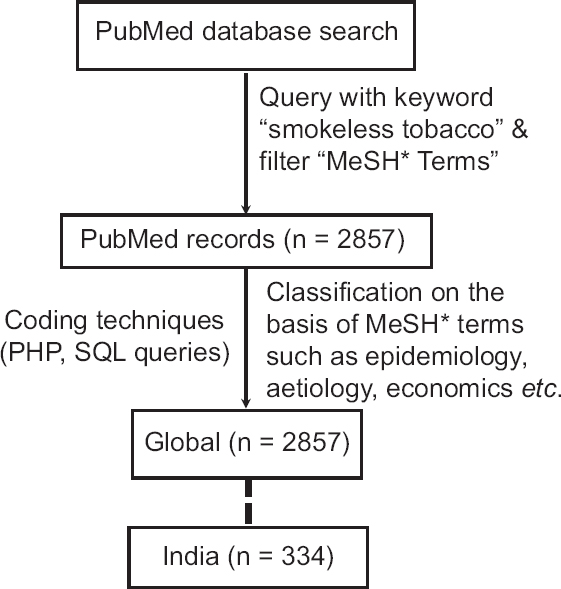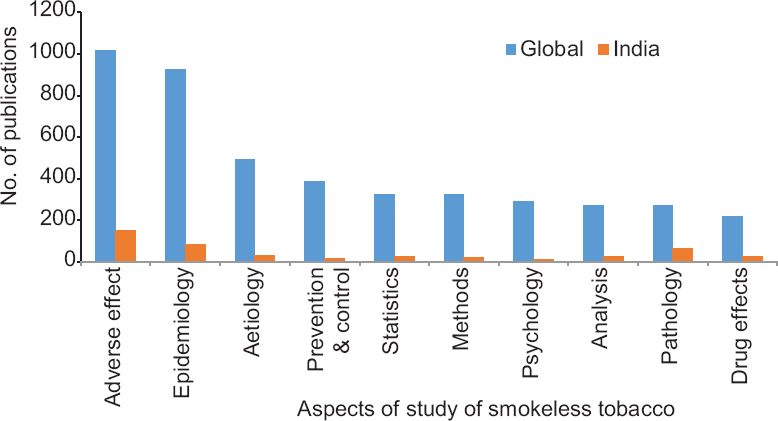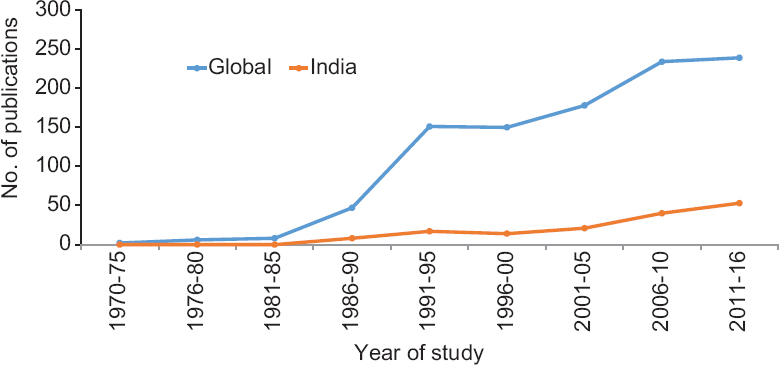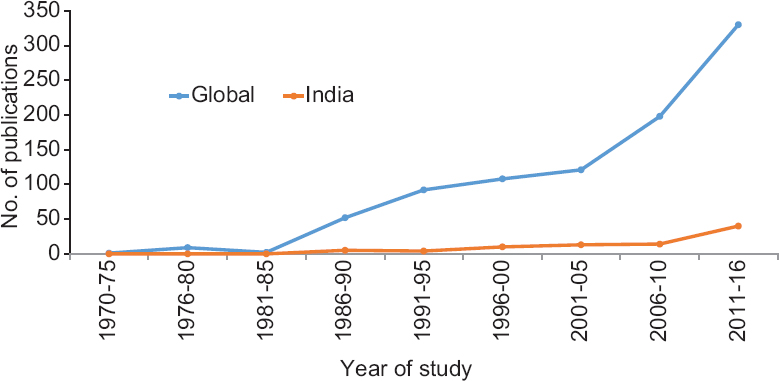Translate this page into:
Setting research priorities in smokeless tobacco control: A retrospective review
For correspondence: Dr Harpreet Singh, Division of Informatics, Systems Research and Management, Indian Council of Medical Research, Ansari Nagar, New Delhi 110 029, India e-mail: hsingh@bmi.icmr.org.in
-
Received: ,
This is an open access journal, and articles are distributed under the terms of the Creative Commons Attribution-NonCommercial-ShareAlike 4.0 License, which allows others to remix, tweak, and build upon the work non-commercially, as long as appropriate credit is given and the new creations are licensed under the identical terms.
This article was originally published by Medknow Publications & Media Pvt Ltd and was migrated to Scientific Scholar after the change of Publisher.
Abstract
Background & objectives:
Smokeless tobacco (SLT) has become a global menace; India being one of the high-burden countries contributes about 67 per cent of its users. Although research is ongoing on various aspects of SLT use and its effects, there is a need to identify the still under-researched areas in this field. This study was aimed at delineating the quantum of research on various topics of SLT, with intent to delineate research gaps for guiding future research priorities.
Methods:
Data about research in SLT were collected from PubMed database using ‘smokeless tobacco’ as a keyword and applying Medical Subject Headings (MeSH) terms filter. Data were extracted in XML (Extensible Markup Language) format and parsed into database to extract necessary fields such as PubMed IDs, authors’ names, affiliations and MeSH terms. Quantum of research in various aspects of SLT was identified for individual MeSH terms and compared for global and Indian data.
Results:
Data analysis of 2857 records revealed that maximum number of articles was devoted to adverse effects (35.6%) followed by epidemiology (32.4%). In comparison, India contributed only 11.7 per cent of records with maximum number of articles on the topics of epidemiology (26%) and adverse effects (45.8%). Higher proportion of research was published on epidemiology, aetiology and prevention and control at global level, while adverse effects of SLT were researched more in Indian studies as compared to global data.
Interpretation & conclusions:
The present analysis highlighted the paucity of research studies on important topics such as economics and alternative strategies of SLT control, both on the global and regional levels.
Keywords
Adverse effects
epidemiology
priorities
research
smokeless tobacco
trend
Smokeless tobacco (SLT) usage, initially considered a regional burden for South-East Asia, has achieved global epidemic proportions with users in 140 countries across all age groups1. The multitude of forms in which SLT products are available for consumption increases the complexity of research in this area. Epidemiology of SLT use across various countries has been receiving fair attention, especially with the inclusion of questions on SLT use in the global adult tobacco survey as well as global youth tobacco survey23.
Considering the scarcity of funds available globally for tobacco control research, there is a need to prioritize research topics likely to have an impact on vulnerable groups in the developing world. Several studies have been done to define priorities in tobacco control in general, with most of the emphases on smoking. A working group at the 10th World Conference on Tobacco or Health in Beijing suggested that research needs for prevention and cessation be found and national research complemented by subnational as well as international research4. Another international committee convened by the Institute of Medicine of the US Academy of Sciences, while preparing a report on cardiovascular diseases in developing countries, recommended prevalence studies, time series monitoring, cost-effectiveness of interventions to prevent smoking, and economic assessment to estimate impact of tobacco production and consumption in developing countries5. A report of regional meetings (Latin America, South and South-east Asia and Africa) delineated recurring themes within each regional agenda apart from specific research issues6. It has also been highlighted that most of the global funding for tobacco control research is utilized in health-related issues rather than multidisciplinary policy-oriented research and majority of this health effect-related research is conducted in the developed countries6. However, no effort has yet been undertaken to consolidate the accessible research data on SLT control and identify the specific areas still requiring attention of researchers. Although systematic reviews and meta-analysis on specific topics of SLT, for instance, adverse health effects, have been published78, a comprehensive review of the available literature highlighting the research priorities has not been conducted. Hence, the present analysis was aimed at consolidating the available literature on SLT control in an effort to delineate the research topics in SLT that should become priority areas for researchers and funding agencies in future.
Material & Methods
Data collection and extraction: Studies conducted on SLT were retrieved from PubMed database from January 1970 to December 2016 using the keyword ‘smokeless tobacco’ and applying filter ‘MeSH terms’ (MeSH stands for Medical Subject Headings). All available articles, irrespective of the language, were included. However, filter was applied to exclude reviews, books and commentaries, letters to editors, conference abstracts and Congress proceedings. The included articles were retrieved and stored in XML (Extensible Markup Language) format.
Further, XML parsing was performed using a scripting language, hypertext pre-processor (PHP) to extract necessary fields such as PubMed IDs, authors’ names (first name, last name), title of journal, affiliations, MeSH terms and year of publication by two authors. Any disagreements between the two authors for these fields were resolved by discussion and mutual consensus. Windows, Apache, MySQL and PHP server was used for the creation of database and execution of PHP scripts. All the necessary information extracted from XML parsing was stored in the database so created. Affiliations corresponding to the first author were used to ascribe countries where SLT research was performed. The methodology adopted for this analysis is depicted in Fig. 1.

- Flowchart depicting methodology adopted for data analysis of PubMed records of smokeless tobacco. MeSH, Medical Subject Headings.
Data analysis: Subsequent to the creation of database, SQL queries were executed for retrieval of data pertaining to the fields of interest in numbers, which were then analyzed for tabulating MeSH term-wise results (global and India) and calculating year-wise trends in the research based on MeSH terms. For global data, due to large number of MeSH terms, only top 10 terms were included in the graph depicting trend.
Test of significance (Z test) between two proportions was applied to compare the global and Indian data.
Results
Data of 2857 records were analyzed to identify the maximum and minimum research conducted in SLT aspects globally as well as in India. Analysis showed the trend and research gaps that varied over time from 1970 to 2016. Maximum number of articles globally was devoted to epidemiology of SLT use (32.4%) and adverse effects of these products (35.6%), as seen from the Table. Compared to the global data, India's contribution to publication in the field of SLT research was at a meagre 11.7 per cent with a total of 334 papers. In India, maximum research was devoted to adverse effects and epidemiology of SLT (Table, Fig. 2).


- Bar diagram showing research in top 10 aspects of study of smokeless tobacco from 1970 to 2016.
Global trend analysis: On a global level, SLT research showed an increasing trend since 1981 although a slight dip was noted in the period from 1991 to 1995. Research on adverse effects as well as epidemiology increased since the start of the 21st century (Figs 3, 4).

- Line diagram depicting the trend analysis of papers on adverse effects of smokeless tobacco (global and India) from 1970 to 2016.

- Trend analysis of research on epidemiology of smokeless tobacco (global and India) from 1970 to 2016.
Trend analysis of publications from India: Despite the huge burden of SLT use in India, focussed research on various aspects of SLT has not been done. Data showed that the research gained some momentum in the period starting from 2000s, both in adverse effects and epidemiology (Figs 3, 4).
Comparison of global and Indian research data: Significantly higher proportion of research was devoted to epidemiology (P<0.05), aetiology (P<0.01) and prevention and control of SLT (P<0.001) at the global level compared to Indian data. On the other hand, significantly higher proportion of studies focussed on adverse effects of SLT were seen in Indian research compared to global data (P<0.001).
Discussion
The paucity of research and dearth of adequate evidence base on the extent of problem and harmful effects of SLT lead to barriers in effective implementation of SLT control measures by the interested stakeholders9. A recent study by Suliankatchi et al10 reported a shift in the preference of tobacco users from smoking to SLT use in SEAR countries including Bangladesh, India and Nepal. It has been shown that users who start with low-nicotine ‘starter’ products are likely to subsequently ‘graduate’ to products with higher-nicotine content11. These facts suggest the urgent need of implementation of SLT control by all countries faced with the problem of rising prevalence of its use. Due to lack of consolidated data on the extent and areas of research in SLT, funding current and future research, especially in high-burden but low-income countries, is an uphill task. Hence, we attempted to consolidate the currently available research in the field of SLT and identify the research gaps and delineate topics that should be research priority for the interested stakeholders.
Our analysis demonstrated that adverse effects of SLT and epidemiological aspects have received the greatest attention of researchers. Epidemiological survey of SLT users is necessary to monitor the changing prevalence as well as evolution and geographic spread of new products11.
Important topics such as prevention and control of SLT, psychosocial aspects, economics and supply and distribution have not received adequate research attention till now. Evaluation of psychological issues such as factors associated with initiation of SLT use and reasons for switch from smoking to SLT products needs to be evaluated to assist the policymakers in implementing better control measures. Similarly, aspects such as economic and health costs of SLT use, including the management of its antecedent health effects, revenue estimates and gainful employment and effects of taxation policies on the consumption of SLT products, need urgent attention of researchers.
Analysis of Indian data showed the relative scant quantum of overall research on SLT with maximum focus on adverse effects and epidemiology, similar to the global data. Research related to topics such as chemistry, pharmacology, isolation and purification and microbiology was lacking from India. This fact assumes great importance considering the vast range of SLT products consumed in various parts of the country1213. Although an all-encompassing study on products available in India has not been conducted so far, a review demonstrated wide variation in the concentration of carcinogens and toxic compounds in some of Indian SLT products14. Such a variation, in turn, may lead to difference in the risk estimates of association of these products with adverse health consequences. This difference in risk estimates is liable to be utilized negatively by the tobacco industry to further their claim of SLT products as a harm-reduction measure for smokers who are not able to quit tobacco completely.
There is also a paucity of literature on economics of SLT in India. Till recently, taxation on SLT products in India was ad valorem, i.e. based on the retail price of the product15. However, an extremely low base price of the SLT products, especially relative to cigarettes, allowed the manufacturers to nullify the effects of taxation increase impose by the government15. The recent introduction of goods and services tax (GST) on a nationwide scale in India imposed a 28 per cent GST on tobacco products and an additional cess that varied from 71 to 204 per cent (160% for zarda and filter khaini, 204% for pan masala with gutka) depending on the product16. The impact of this new tax regimen on the consumption of SLT products is yet to be evaluated. Hence to summarize, maximum research on SLT has been focussed on adverse effects and epidemiology, with significant difference in the proportion of quantum of research between global and Indian data. Vital topics such as economics of SLT, microbiology and prevention and control are yet to receive adequate research attention.
The main strength of the analysis included the innovative design of the study and all-inclusive nature of literature search. The analysis had a few limitations that should be kept in mind while evaluating the results. Since the PubMed search was performed using only the term ‘smokeless tobacco’, this could have led to incomplete retrieval of papers since a few authors might have used terms of specific SLT products in their publications. However, the effect of this would, in all likelihood, have been negligible considering that the term ‘smokeless tobacco’ is the most frequently used phrase in such articles. The search was based on MeSH terms, and this might have led to a slight overestimation of the total number of publications. Statistical analysis revealed a difference between global and Indian research data; however, since individual articles contained multiple MeSH terms, the comparison might be somewhat erroneous.
In conclusion, the present analysis highlighted the paucity of data on important topics such as economic costs and alternative strategies for SLT control. Due to overall scarcity of research funds available, there is a need for prioritization of research topics that may be guided by the consolidated data provided by our study.
Financial support & sponsorship: This work was financially supported by the project “WHO FCTC Global Knowledge Hub on Smokeless Tobacco” (Reference No. 2016/643768-0).
Conflicts of Interest: None.
References
- The poorest of poor suffer the greatest burden from smokeless tobacco use: A study from 140 countries. Nicotine Tob Res 2017 December 22 doi 10.1093/ntr/nt3c276
- [Google Scholar]
- Global youth tobacco survey (GYTS): Core questionnaire with optional questions, version 1.2. 2014. Atlanta, GA: Centers for Disease Control and Prevention; Available from: http://www.paho.org/hq/index.php?option=com_docman&task=doc_view&gid=41043&Itemid=270&lang=en
- [Google Scholar]
- Global adult tobacco survey (GATS): Core questionnaire with optional questions, version 2.0. 2010. Atlanta, GA: Centers for Disease Control and Prevention; Available from: http://www.who.int/tobacco/surveillance/en_tfi_gats_corequestionnairewithoptionalquestions_v2_FINAL_03Nov 2010.pdf
- [Google Scholar]
- Research for effective global tobacco control in the 21st century: Report of a working group convened during the 10th World Conference on Tobacco or Health. Tob Control. 1998;7:72-7.
- [Google Scholar]
- Control of cardiovascular diseases in developing countries: Research, development, and institutional strengthening. Washington, DC: The National Academies Press; 1998.
- [Google Scholar]
- Research priorities for tobacco control in developing countries: A regional approach to a global consultative process. Tob Control. 2000;9:217-23.
- [Google Scholar]
- Global burden of all-cause and cause-specific mortality due to smokeless tobacco use: Systematic review and meta-analysis. Tob Control. 2018;27:35-42.
- [Google Scholar]
- Risk of coronary heart disease among smokeless tobacco users: Results of systematic review and meta-analysis of global data. Nicotine Tob Res 2018 Jan 9 doi:10.1093/ntr/nty002
- [Google Scholar]
- A policy perspective on the global use of smokeless tobacco. Curr Addict Rep. 2017;4:503-10.
- [Google Scholar]
- Smokeless tobacco use is ‘replacing’ the smoking epidemic in the South East Asia region. Nicotine Tob Res 2017 Dec 22 doi: 10.1093/ntr/ntx272
- [Google Scholar]
- National Cancer Institute and Centers for Disease Control and Prevention. Smokeless tobacco and public health: A global perspective. NIH Publication No. 14-7983. Bethesda, MD: US Department of Health and Human Services, Centers for Disease Control and Prevention and National Institutes of Health, National Cancer Institute; 2014.
- [Google Scholar]
- Report on oral tobacco use and its implication in South East Asia. 2004. New Delhi: World Health Organization, Regional Office for South East Asia; Available from: http://www.searo.who.int/tobacco/topics/oral_tobacco_use.pdf
- [Google Scholar]
- Global surveillance of oral tobacco products: Total nicotine, unionised nicotine and tobacco-specific N-nitrosamines. Tob Control. 2011;20:e2.
- [Google Scholar]
- Economics of smokeless tobacco in India. 2016. Smokeless tobacco and public health in India. New Delhi: Ministry of Health & Family Welfare, Government of India; Available from: https://www.mohfw.gov.in/sites/default/files/Final%20Version%20of%20SLT%20Monograph.pdf
- [Google Scholar]
- Excise duty on cigarette, tobacco removed as GST comes into force. Available from: http://www.deccanchronicle.com/business/economy/030717/excise-duty-on-cigarette-tobacco-removed-asgst-comes-into-force.html
- [Google Scholar]






